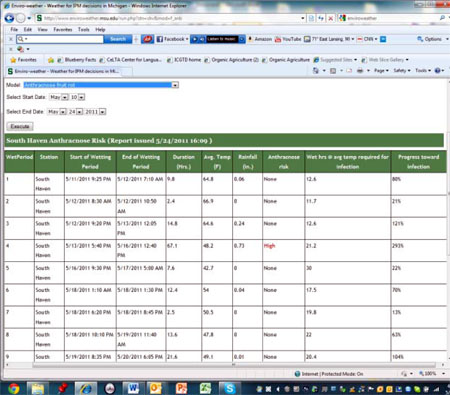Anthracnose infection risk model launched on Enviro-weather
Use Enviro-weather’s anthracnose fruit rot model to track potential for this infection from bloom until harvest.
The anthracnose fruit rot model is now available on the Enviro-weather website. The model indicates the risk of fruit infection from bloom until harvest, assuming that Colletotrichum acutatum inoculum is available in the field. If you have a susceptible cultivar and have had anthracnose fruit rot in the past, this is a likely assumption, particularly in the period from bloom until pea-size berry and during fruit ripening.
The risk of infection is based on wetness duration and temperature that promote fungal spore germination and penetration of the fruit surface. The closer to the optimum temperature (77°F) and the longer the fruit stays wet (from rain, dew or irrigation), the greater the risk of infection. The risk is indicated as “none,” “low,” “moderate” or “high.” The model can only use past weather information, which means that it can tell you what the risk of infection was last night, but not what it will be a week from now.
The model uses weather data from Enviro-weather weather stations throughout Michigan. You can look online to find out what the model says for the weather station closest to your farm. To access the model, go to Enviro-weather, then pick the station of your choice by clicking on the dot on the Michigan map, then go to “Fruit” (top green bar). Then under “Blueberry” on the left, select “Anthracnose fruit rot.” The output looks like this image.

You can change the weather station in the upper left corner and run the model for that weather station by pressing the “Execute” button.
The anthracnose risk model will give you an indication of the weather conditions that constitute high-risk for anthracnose fruit rot, and is a learning tool as well as a management tool. Growers can use it for preventive fungicide sprays (Captan, Ziram, Pristine, Cabrio, Abound, Omega) when the weather forecast is predicting weather with potentially long wetness periods (e.g., longer than 18 to 24 hours) or apply post-infection sprays if the plants were unprotected during an infection period. It is up to the grower to decide how much risk he or she is willing to take, but it is a safe bet to use at least “moderate” risk as a trigger for action.
Systemic fungicides such as Pristine, Abound, Cabrio and Omega should be applied to green fruit within 24 to 48 hours after the model calls for an infection period to get curative activity. Once a fungicide has been applied, the plants are considered covered for the next 10 to 14 days (depending on the length of the residual activity of the fungicide) and the model can be considered again at the end of the spray interval. If a lot of rain has fallen since the last application, you may want to shorten the interval.
Dr. Schilder’s work is funded in part by MSU’s AgBioResearch.



 Print
Print Email
Email



